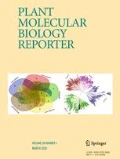Abstract
A quick, simple, and reliable method for the extraction of DNA from grapevine species, hybrids, andAmpelopsis brevipedunculata (Vitaceae) has been developed. This method, based on that of Doyle and Doyle (1990), is a CTBA-based extraction procedure modified by the use of NaCl to remove polysaccharides and PVP to eliminate polyphenols during DNA purification. The method has also been used successfully for extraction of total DNA from other fruit species such as apple (Malus domestica), apricot (Prunus armeniaca), cherry (Prunus avium), peach (Prunus persica), plum (Prunus domestica), and raspberry (Rubus idaeus). DNA yield from this procedure is high (up to 1 mg/g of leaf tissue). DNA is completely digestible with restriction endonucleases and amplifiable in the polymerase chain reaction (PCR), indicating freedom from common contaminating compounds.
Similar content being viewed by others
Abbreviations
- CTAB:
-
cetyltrimethylammonium bromide
References
Arumuganathan, K. and E.D. Earle 1991. Nuclear DNA content of some important plant species. Plant Mol. Biol. Rep. 9:208–218.
Baribault, T.J., K.G.M. Skene and N.S. Scott. 1989. Genetic transformation of grapevine cells. Plant Cell Rep. 8:137–140.
Baribault, T.J., K.G.M. Skene, P.A. Cain and N.S. Scott. 1990. Transgenic grapevines: Regeneration of shoots expressing β-glucuronidase. J. Exp. Bot. 41:1045–1049.
Bourquin, J.-C., L. Otten and B. Walter 1991. Identification of grapevine root-stocks by RFLP. C.R. Acad. Sci. Paris 312 Série III:593–598.
Collins, G.G. and R.H. Symons 1992. Extraction of nuclear DNA from grape vine leaves by a modified procedure. Plant Mol. Biol. Rept 10:233–235.
Collins, G.G. and R.H. Symons. 1993. Polymorphisms in grapevine DNA detected by the RAPD PCR technique. Plant Mol. Biol. Rept. 11:105–112.
Couch, J.A. and P.J. Fritz. 1990. isolation of DNA from plants high in polyphenolics. Plant Mol. Biol. Rep. 8:8–12.
Doyle, J.J. and J.L. Doyle. 1987. A rapid DNA isolation procedure from small quantities of fresh leaf tissues. Phytochem Bull. 19:11–15.
Doyle, J.J. and J.L. Doyle 1990. Isolation of plant DNA from fresh tissue. Focus 12:13–15.
Fang, G., S. Hammar and R. Rebecca 1992. A quick and inexpensive method for removing polysaccharides from plant genomic DNA. Bio Techniques 13:52–56.
Hain, R., H.J. Reif, E. Krause, R. Langebartels, H. Kindl, B. Vornam, W. Wiese, E. Schmelzer, P.H. Schreier, R.H. Stöcker and K. Stenzel 1993. Disease resistance results from foreign phytoalexin expression in a novel plant. Nature 361:153–156.
Hébert D., J.R. Kikkert, F.D. Smith and B.L. Reisch 1993. Optimization of biolistic transformation of embryogenic grape cell suspensions. Plant Cell Rep. 12:585–589.
Howland, D.E., R.P. Oliver and A.J. Davy. 1991. A method of extraction of DNA from birch. Plant Mol. Biol. Rep. 9:340–344.
Katterman, F.R.H. and V.L. Shattuck. 1983. An effective method of DNA isolation from the mature leaves ofGossypium species that contain large amounts of phenolic terpenoids and tannins. Preparative Biochemistry 13:347–359.
Lodhi, M.A., B.l. Reisch and N.F. Weeden. 1992a. Molecular genetic mapping and genome size ofVitis. Plant Genome I, 9–11 November, San Diego, CA, USA (Abstract).
Lodhi, M.A., B.L. Reisch and N.F. Weeden 1992b. Molecular genetic mapping of theVitis genome. Am. J. Enol. Vitic. 43:393 (Abstract).
Lodhi, M.A., B.l. Reisch and N.F. Weeden 1993. Molecular genetic mapping and genome size ofVitis. Hort Science 28:489 (Abstract #289).
Maliyakal, E.J. 1992. An efficient method for isolation of RNA and DNA from plants containing polyphenolics. Nucleic Acids Res. 20:2381.
Mauro, M.-C., M. Strefeler, N.F. Weeden and B.I. Reisch. 1992. Genetic analysis of restriction fragment length polymorphisms in Vitis. J. Hered. 83:18–21.
Murray, M.G. and W.F. Thompson. 1980. Rapid isolation of high molecular weight DNA. Nucleic Acids Res. 8:4321–4325.
Richards, E. 1988. Preparation of genomic DNA from plant tissue. In:Current Protocols in MolecularBiology (eds. F.M. Ausubel, R.E. Kingston, D.D. Moore, J.A. Smith, J.G. Seidman and K. Struhl), pp. 2.3.2–2.3.3. Greene Publishing Associates and Wiley-Interscience, New York.
Rogers, S.O. and A.J. Bendich. 1985. Extraction of DNA from milligram amounts of fresh, herbarium and mummified plant tissues. Plant Mol. Biol. 5:69–76.
Rowland, L.J. and B. Nguyen. 1993. Use of polyethylene glycol for purification of DNA from leaf tissue of woody plants. Bio Techniques 14:734–736.
Shioda, M. and K. Marakami-Muofushi 1987. Selective inhibition of DNA polymerase by a polysaccharide purified from slime ofPhysarum polycephalum. Biochem. Biophys. Res. Commun. 146:61–66.
Southern, E.M. 1975. Detection of specific sequences among DNA fragments separated by gel electrophoresis. J. Mol. Biol. 98:503–517.
Striem, M.J., P. Spiegel-Roy, G. Ben-Hayyim, J. Beckmann and D. Gidoni. 1990. Genomic fingerprinting ofVitis vinifera by the use of multi-loci probes. Vitis 29:223–227.
Thomas, M.R., S. Matsumoto, P. Cain and N.S. Scott. 1993. Repetitive DNA of grapevine: classes present and sequences suitable for cultivar identification. Theor. Appl. Genet. 86:173–180.
Webb, D.M. and S.J. Knapp. 1990. DNA extraction from a previously recalcitrant plant genus. Plant Mol. Biol. Rep. 8:180–185.
Weeden, N.F., G.M. Timmerman, M. Hemmat, B.E. Kneen and M.A. Lodhi. 1992. Inheritance and reliability of RAPD markers. In:Proceedings of the Joint Plant Breeding Symposium Series. Applications of RAPD Technology to Plant Breeding. Crop Science Scociety of America, American Society for Horticultural Science and American Genetic Association. pp. 12–17.
Williams, J.G.K., A.R. Kubelik, K.J. Livak, J.A. Rafalski and S.V. Tingey. 1990. DNA polymorphisms amplified by arbitrary primers are useful as genetic markers. Nucleic Acids Res. 18:6531–6535.
Yamamoto, N., G. Ono, K. Takashima and A. Totsuka. 1991. Restriction fragment length polymorphisms of grapevine DNA with phenylalanine ammonia-lyase cDNA. Jap. J. Breed. 41:365–368.
Author information
Authors and Affiliations
Rights and permissions
About this article
Cite this article
Lodhi, M.A., Ye, GN., Weeden, N.F. et al. A simple and efficient method for DNA extraction from grapevine cultivars andVitis species. Plant Mol Biol Rep 12, 6–13 (1994). https://doi.org/10.1007/BF02668658
Issue Date:
DOI: https://doi.org/10.1007/BF02668658




